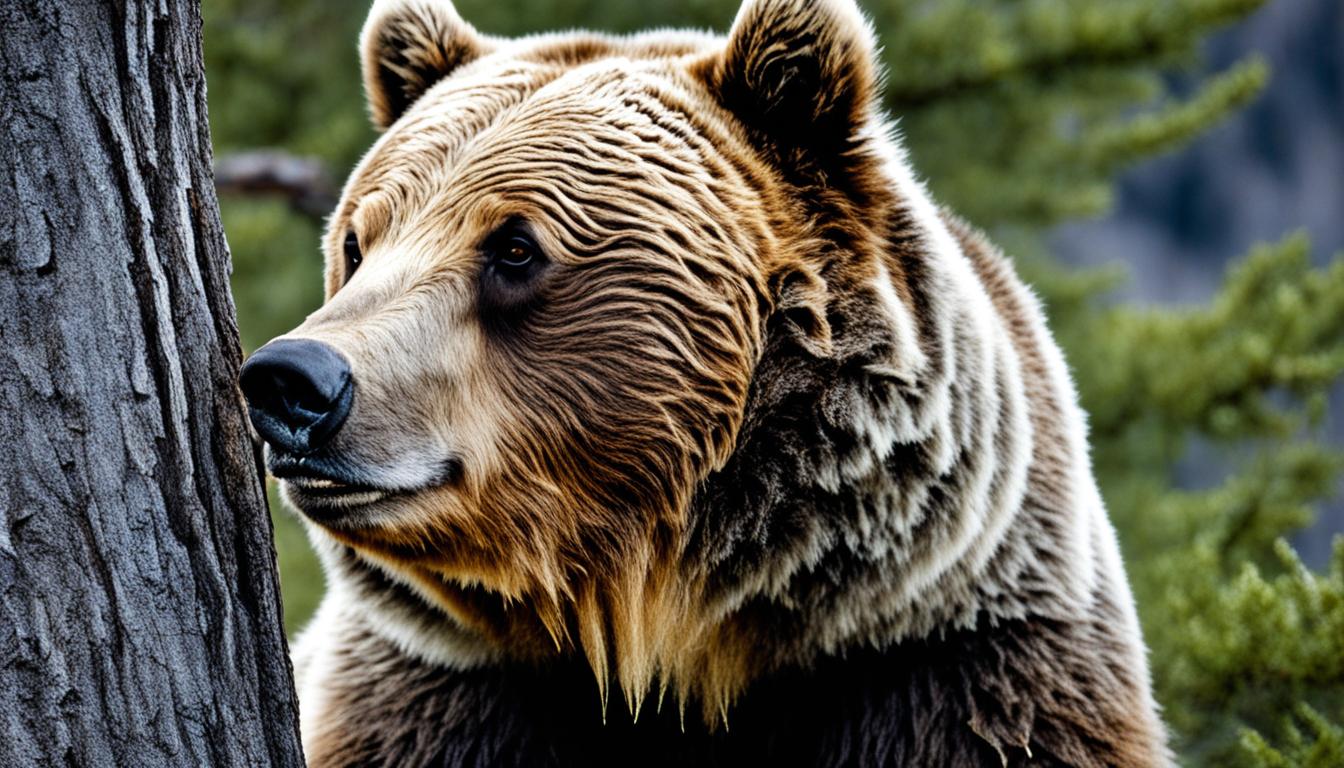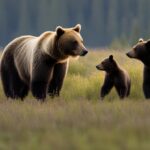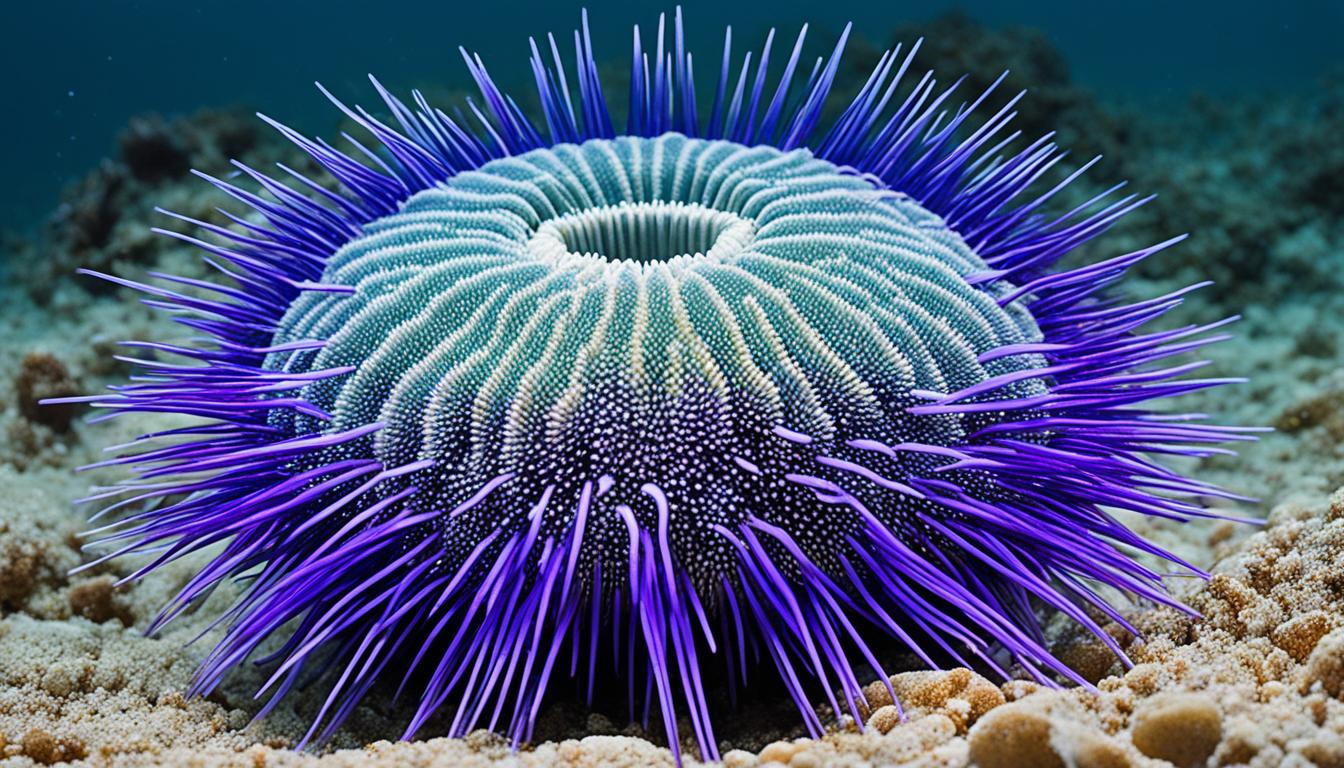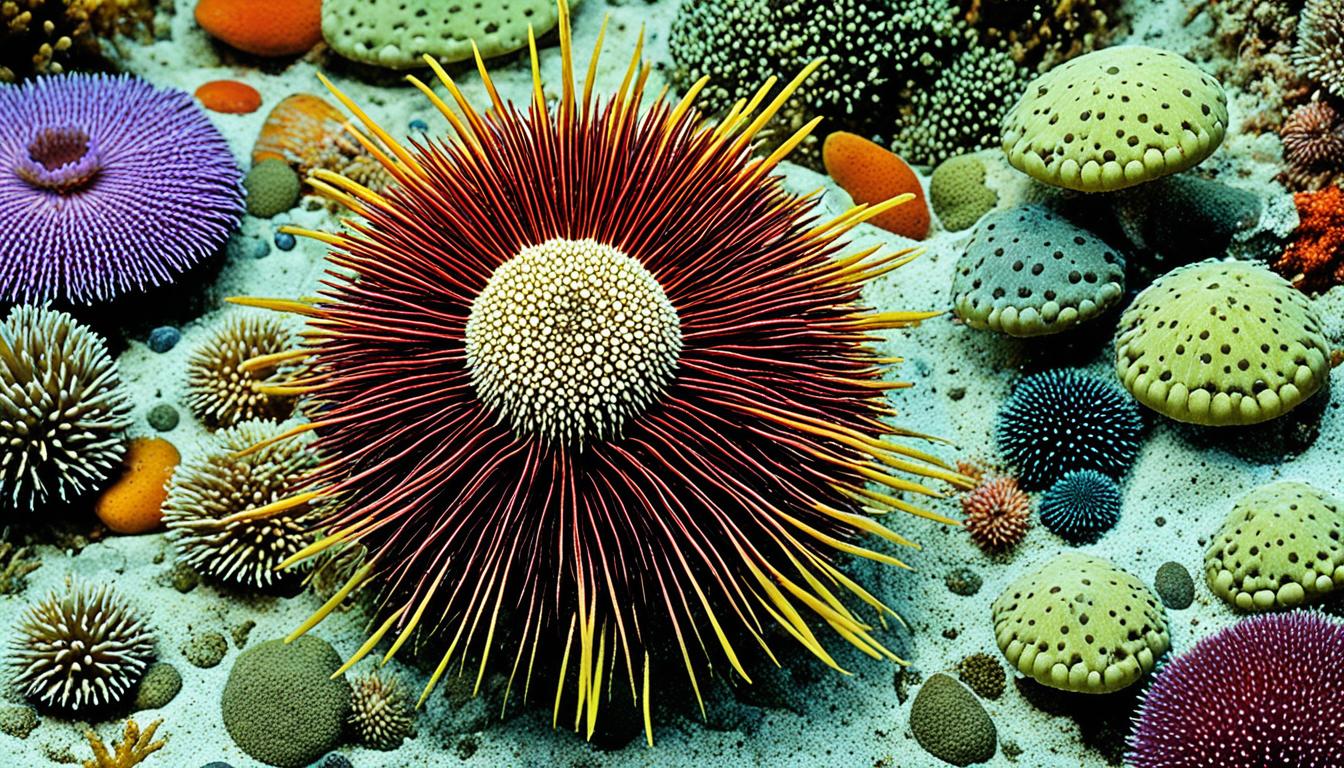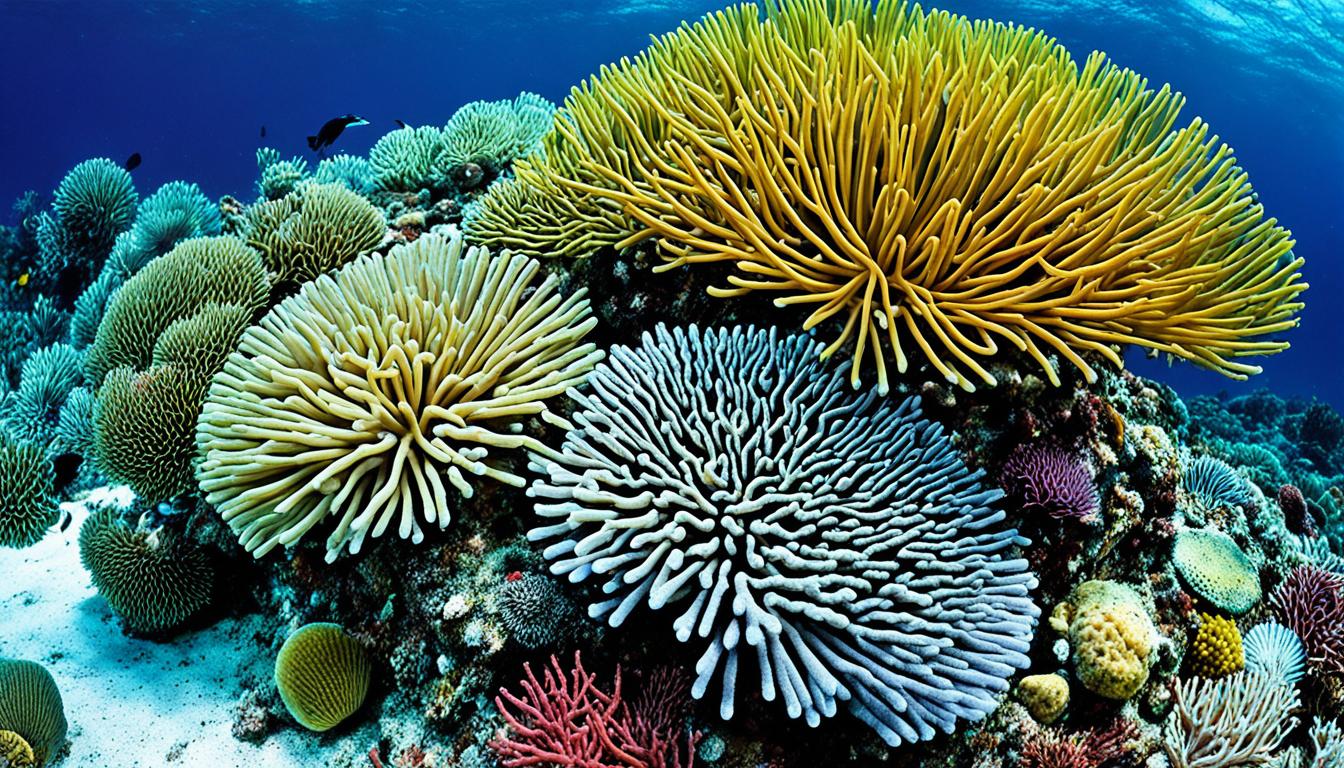Grizzly bears (*Ursus arctos horribilis*) are truly remarkable animals found in North America. Many people are curious about how long they live. Generally, these stunning creatures can reach 25 years in the wild. Their lifespan is impacted by what they eat, where they live, and how humans interact with them. Let’s explore the wild grizzly bear age and what affects how long they live.
Introduction to Grizzly Bears
Grizzly bears are a key part of North America, known scientifically as Ursus arctos horribilis. They stand out for their big size and unique habits. A big bump of muscle on their shoulders helps them dig and adds to their strength.
They have long, sharp claws and their fur can be light brown or nearly black. This camouflages them in many places. They are also incredibly strong, able to move big rocks and trees while they look for food.
In the wild, grizzly bears are very important. But in some areas, like Idaho, they are at risk and considered “Threatened.” Protecting them and their homes is more important than ever.
Knowing about the scientific, physical, and conservation aspects of grizzlies is a big help. This info is key for learning about their life span and the hurdles they face in the wild.
| Attribute | Details |
|---|---|
| Scientific Name | Ursus arctos horribilis |
| Distinguishing Feature | Prominent shoulder hump |
| Claw Length | Up to 4 inches |
| Fur Color | Varies from light brown to dark black |
| Conservation Status in Idaho | Threatened |
Average Lifespan of Grizzly Bears
The grizzly bear longevity is greatly affected by its habitat. Typically, a wild grizzly lives around 25 years. Yet, those in captivity can see over 30 years, showing a big difference.
Take Shoni and Stripes for example, they show this difference well. Shoni lived in the wild and made it to 23. Stripes, in captivity, lived up to 31 years.
This shows how their surroundings can change a grizzly’s life span. Places that keep them safe and well-fed, with access to healthcare, help them live longer.
| Grizzly Bear | Living Environment | Lifespan |
|---|---|---|
| Shoni | Wild | 23 years |
| Stripes | Captivity | 31 years |
Research shows that on average, wild grizzly bears live shorter lives. This highlights the dangers they face in their natural environment.
What is the Lifespan of a Grizzly Bear in the Wild?
Grizzly bears live two to three decades in the wild. Many things affect this, such as where they live, food, and their genes.
“A grizzly’s life span in the wild largely hinges on the delicate balance of nature’s offerings and its survival instincts,” notes wildlife biologist Sarah Lockwood.
When thinking about a grizzly bear’s life, we must consider the wild’s challenges. They adapt to changes in weather and outsmart predators. Studies show they usually live around 25 years. But, a few may live longer in the best conditions.
- Diet and Nutrition: A rich, diverse diet including plants, fish, and mammals is essential for a grizzly’s longevity.
- Habitat Quality: Access to protected areas with abundant food sources plays a crucial role in their survival.
- Human Activity: Minimizing human interference helps in enhancing their lifespan.
Learning about a grizzly’s life means looking at what helps them live longer. Their ability to survive shows why we need to protect them and their homes. Conservation is key to keeping these amazing animals around.
Factors Affecting Grizzly Bear Longevity
Why do grizzly bears live as long as they do in the wild? Well, many things really matter. What they eat, the place they live, and how humans interact with them all have a big say. These factors decide the lives of these amazing animals.
Diet and Nutrition
Grizzly bears eat many things, making them omnivores. They enjoy a variety of foods like fruits, nuts, and even small fish. This broad diet gives them all the nutrients they need, keeping them healthy for a long time.
Finding different kinds of food is key. Grizzlies live in places with lots to eat, such as alpine meadows. Here, they can find plants and animals throughout the year. This richness in food can add years to their life.
Habitat Conditions
Where grizzly bears live is very important for their survival. Their homes usually include open areas, riversides, and thick forests. The quality of these places affects their food and shelter, impacting their health.
Take alpine meadows, for instance. Grizzlies get a big meal in the spring and summer here. Such places can help them live longer, with better health.
Human Interaction and Threats
Humans are a big threat to grizzly bears. They are losing their homes to farming, cutting trees, and building. Often, human-bear encounters end badly for both, putting the bears at risk.
Killing predators and hunting are also dangers. This makes protecting grizzlies very important. Keeping them safe from people means they can live their full lives in the wild.
Understanding these factors is key to grasping the intricate balance required for the longevity of grizzly bears in their natural habitats.
Lifespan Differences: Wild vs. Captivity
Grizzly bears show a big difference in how long they live, whether they’re free or in captivity. In the wild, bears face many dangers that can cut their lives short. But in captivity, they live in a safe place without these natural threats.
Out in nature, grizzly bears struggle to find food and dodge dangers from humans and diseases. These issues can cut their lives down. They usually live just 20 to 25 years because of these challenges.
On the other hand, bears in captivity often live longer than 30 years. They get regular food, health checks, and don’t have to worry about natural enemies. Shoni and Stripes, two famous bears in zoos, have lived much longer lives than bears in the wild.
| Factors | Wild Grizzly Bears | Captive Grizzly Bears |
|---|---|---|
| Average Lifespan | 20-25 years | 30-35 years |
| Food Availability | Variable, often scarce | Consistently provided |
| Human Threats | High | Low |
| Disease and Injury | Frequent | Rare with veterinary care |
In captivity, bears have a steady diet and get checkups, which helps them live longer. This difference in lifespan highlights how much environment affects a grizzly bear’s life.
Grizzly Bear Survival Rates
It’s vital to know the survival rates of grizzly bears to understand their life in the wild. We look at what affects their survival, from cub’s dangerous beginnings to the challenges adults face.
Infant Mortality
Young grizzly bear cubs have a tough start, with many not making it. A big part of bear reproduction is a trick called delayed implantation. This means the egg waits to grow until it’s the best time. With help from their mothers, this helps more cubs survive. But bad weather and not enough food are still big problems.

Adult Survival Challenges
Grown grizzly bears have their own set of challenges for staying alive. Things like environmental threats from climate change are a big deal. As the places they live and eat change, life gets harder. Humans are also a big threat, with things like taking their space, hunting them, and accidents with cars making survival tough.
| Survival Factors | Impact on Grizzlies | Notes |
|---|---|---|
| Infant Mortality Rate | High | Due to environmental threats and food scarcity |
| Bear Reproduction | Delayed Implantation | Strategy to optimize cub birth timing |
| Adult Grizzly Bear Survival | Threatened | By climate change and human interaction |
| Environmental Threats | Significant | Climate change and habitat destruction |
| Bear Conservation Efforts | Critical | Necessary to mitigate survival challenges |
Grizzly bears need our help to survive better. By looking at these key issues, we see why bear conservation efforts are so vital. They shed light on the urgent environmental problems grizzly bears face today.
Comparison with Other Bear Species
Let’s look at Kodiak bears and American black bears, compared to grizzly bears. Each bear type is special. They differ in size, where they live, and how long they live.
Kodiak Bears
Kodiak bears are big, really big. They are a subspecies of brown bear. These bears live in the Kodiak Archipelago, Alaska. They grow large mainly because of a lot of salmon to eat.
American Black Bears
American black bears are smaller than grizzlies and Kodiak bears. They live in many places in North America. This includes forests and swamps.
They can live for about 20 years in the wild. This is longer than many grizzly bears. They face lesser dangers from other predators and people. Different environments affect bear lifespans.
| Bear Species | Scientific Name | Average Lifespan | Habitat |
|---|---|---|---|
| Grizzly Bear | Ursus arctos horribilis | 20-25 years | Forests, alpine meadows |
| Kodiak Bear | Ursus arctos middendorffi | 20-25 years | Kodiak Archipelago |
| American Black Bear | Ursus americanus | 18-20 years | Forests, swamps |
Studying Kodiak and American black bears next to grizzlies shows how varied bears are. Size, where they live, and their genes are all key. They help these bears live and adapt.
The Role of Wildlife Conservation
Wildlife conservation is key in helping grizzly bears live naturally. Things like Alberta BearSmart and laws like the Endangered Species Act help a lot. They work to save grizzly bears and their homes.
Alberta BearSmart aims to lessen bear and human conflicts. This protects grizzly bears. They teach people how to share space safely with bears. It shows that saving animals needs everybody, not just laws.
The Endangered Species Act makes protected areas and helps animals in danger. It includes better logging and limits on building near bears.
“The Endangered Species Act has been key in saving grizzly bears in the U.S.,” says the U.S. Fish and Wildlife Service.
| Conservation Initiative | Key Focus | Impact on Grizzly Bears |
|---|---|---|
| Alberta BearSmart | Community Education | Less human-bear conflicts |
| Endangered Species Act | Legal Protection | Keeps habitats safe |
These programs show how critical wildlife conservation and habitat protection are. By backing them, you help save grizzly bears. In doing so, you play a part in making sure they stay safe in the future.
Conclusion on Grizzly Bear Lifespan
Grizzly bear lifespan is influenced by many factors. It includes diet, habitat, and human interactions. They live in areas like alpine meadows and forests, which provide a range of food. But these places also pose threats like habitat loss.
Wild and captive grizzlies have different lifespans. Wild ones live about 25 years, dealing with the challenges of nature. Yet, those in captivity can live over 30 years due to consistent food and care. This shows why protecting wild spaces is critical for grizzly bears.
When we compare grizzlies to Kodiak and black bears, we see unique challenges. Improving conservation efforts and laws is key. This will help grizzly bears live longer by ensuring healthy habitats and reducing conflicts with humans. It’s clear that with the right measures, we can ensure a bright future for grizzly bears in the wild.

